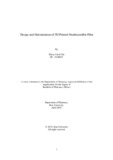| dc.contributor.advisor | Kabir, Eva Rahman | |
| dc.contributor.advisor | Yasmin, Hasina | |
| dc.contributor.author | Ohi, Illiyun Litch | |
| dc.date.accessioned | 2020-02-16T05:22:42Z | |
| dc.date.available | 2020-02-16T05:22:42Z | |
| dc.date.copyright | 2019 | |
| dc.date.issued | 2019-04 | |
| dc.identifier.other | ID 14146037 | |
| dc.identifier.uri | http://hdl.handle.net/10361/13757 | |
| dc.description | This thesis is submitted in partial fulfilment of the requirements for the degree of Bachelor of Pharmacy, 2019. | en_US |
| dc.description | Cataloged from PDF version of thesis report. | |
| dc.description | Includes bibliographical references (pages 44-50). | |
| dc.description.abstract | The oral route of drug administration is an alternative and preferable route over other available routes as it is considered to be the safest and effective route of administration. For this reason, the number of marketed oral medication is increasing day by day. The benefits of 3D printed oral medication are also emerging. As elderly patients and patients suffering from mental disorders and motion sickness cannot swallow oral tablets easily, orodispersible films are most suited for them. Orodispersible films are mainly similar to conventional tablets but very thin in appearance and consist of super disintegrants which allow them to dissolve in the mouth. These films are designed to attach to the buccal cavity in order to provide therapeutic action. 3D printing technology is a process through which three dimensional objects can be prepared from the aid of a digital file. This technology utilizes a virtual model to produce physical objects using controlled apparatuses. Several methods and different softwares can be used to formulate a 3D printed orodispersible film. Autodesk MAYA 2018 is a software that can effectively design orodispersible films with appropriate information and data. The present study incorporates the use of this software through which fifteen orodispersible films were designed. Therefore, this paper attempts to provide an overview of the methods and designing properties of 3D printed orodispersible films and their numerous applications and advantages. | en_US |
| dc.description.statementofresponsibility | Illiyun Litch Ohi | |
| dc.format.extent | 50 pages | |
| dc.language.iso | en | en_US |
| dc.publisher | Brac University | en_US |
| dc.rights | Brac University theses are protected by copyright. They may be viewed from this source for any purpose, but reproduction or distribution in any format is prohibited without written permission. | |
| dc.subject | Orodispersible films | en_US |
| dc.subject | 3D printing technology | en_US |
| dc.subject | Drug administration | en_US |
| dc.subject.lcsh | Three-dimensional printing. | |
| dc.subject.lcsh | Medical technology. | |
| dc.title | Design and optimization of 3D printed Orodispersible Film | en_US |
| dc.type | Thesis | en_US |
| dc.contributor.department | Department of Pharmacy, Brac University | |
| dc.description.degree | B. Pharmacy | |

